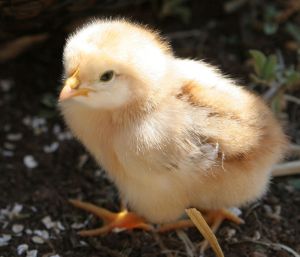Kate Whiston, University of Nottingham

Source: Wikimedia Commons
It’s that time of year; fields are bursting with prancing lambs, cows graze on the lush Spring grass, and cute chicks are as abundant in incubators as they are on Easter cards. What better time than to remind ourselves of the ongoing debates surrounding farm animal welfare that proliferate scientific, political, and public realms, and – more importantly to the geographers amongst us – the relevance of geography to these debates.
Johnston’s (2013) article in Geography Compass identifies two areas of geography that contribute theoretically to animal welfare research. Firstly, the geography of science, part of the broader field of Science and Technology Studies (STS), views scientific knowledge production as spatially, culturally, and historically grounded. That’s to say, research in animal welfare is constituted by spatial, cultural, and historical factors. Secondly, animal geography views animals as active political agents, and engages with animal subjectivity, the spaces they live in, and their moral rights.
This consideration of subjective well-being is a relatively new addition to the previously physiologically-orientated assessment of farm animal welfare. Animal subjectivity is not directly measurable, although it may be indirectly measured through an animal’s cognitive capacities. Animal scientists believe cognitive capacity to be linked to animals’ ability to suffer emotionally and to be consciously aware of their experiences. Needless to say, farm animals are cleverer than we think, not quite to the extent that George Orwell portrays in Animal Farm, but they still have mental and emotional capacities far greater than is accredited to them.
A recent article on Dairy Herd Management’s website discusses the practicalities of implementing this idea of farm animal subjectivity. According to the article, there are three main measures for evaluating dairy cow welfare; ‘biological functioning’ (animal health and productivity), ‘affective state’ (emotions), and ‘natural living’ (ability to behave naturally). Farmers strive to optimise the biological function of their dairy cows, whilst trying to avoid compromising their subjective welfare. A further farming article, this time on Farming UK’s website, has illustrated the subjective welfare of free range chickens. Farmers with chickens emphasise the welfare benefits of letting them roam free outdoors. ‘Natural living’ – interacting with other chickens and their environment – farmers argue, allows chickens to live happier, more ethical lives.

Source: Wikimedia Commons
Further emphasising geography’s relevance, Johnston also identifies and investigates three ‘spaces’ of knowledge production in farm animal welfare research. The first is geopolitical ‘space’; animal welfare is often part of the public agenda and parliamentary reform, meaning that farm animals are enrolled in human political systems. All farm animals are political subjects; in true Animal Farm style, they actively shape farm infrastructure, research agendas, and policies. The second ‘space’ is the research environment itself. Making use of Actor Network Theory (ANT), geographers have suggested that the production of knowledge in farm animal welfare research is tied up in networks of people, animals, and institutions. The third and final ‘space’ of knowledge production is the most complex; animals’ spaces, or the ‘location’ of their subjective experience. These spaces are two fold; animals’ bodies (in their nervous system) and animals’ environments (the spaces that they inhabit). Thus, farm animal subjectivity is relational, produced through their interactions with their environments. The production of knowledge in animal welfare research is, therefore, complexly linked to politics, science, and the animals themselves.
So next time you see farm animals blissfully frolicking in a farmer’s fields, remember that all is not as it seems in this typical Spring scene. The animals may seem passive and content, but they are, in fact, active political subjects with cognitive capacities strong enough to feel emotional and physical suffering, and to be consciously aware of their experiences. Along with scientists and activists, farm animals themselves are fighting an inherently geographical battle to improve farm animal welfare.

Source: Wikimedia Commons
![]() Johnston, C.L. (2013). “Geography, Science, and Subjectivity: Farm Animal Welfare in the United States and Europe”, Geography Compass, 7(2):139-148.
Johnston, C.L. (2013). “Geography, Science, and Subjectivity: Farm Animal Welfare in the United States and Europe”, Geography Compass, 7(2):139-148.
 http://www.dairyherd.com/news/successful-animal-welfare-planning-your-farm
http://www.dairyherd.com/news/successful-animal-welfare-planning-your-farm
 http://www.farminguk.com/News/Egg-producers-promote-a-million-reasons-to-choose-free-range-_30965.html
http://www.farminguk.com/News/Egg-producers-promote-a-million-reasons-to-choose-free-range-_30965.html

Your way of explaining is great. I like your post about farm animal. I liked the valuable information that you provide in this post. Keep up sharing such nice information with us.